Witnessing the monarch butterfly life cycle stages from caterpillar to chrysalis to butterfly over the course of a few weeks in our own backyard has been one of the most uplifting and amazing experiences.
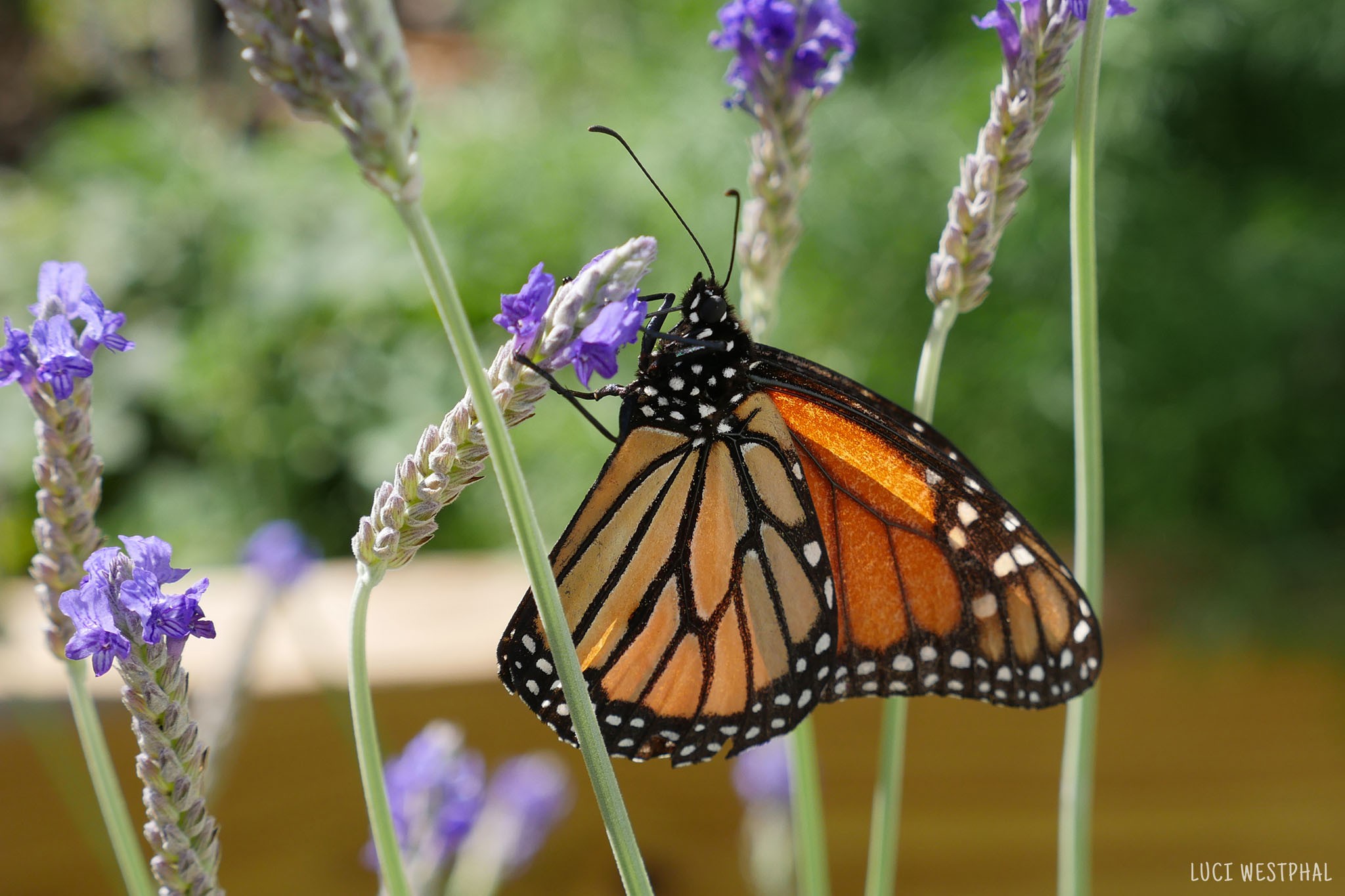
Since late February, I’ve captured photos and videos of the different monarch butterfly life cycle stages and transformation right here in my own and my neighbor’s backyard in the Historic Kenwood neighborhood of St. Petersburg, Florida.
What started with my neighbor Joanne showing me caterpillars in her yard and a chrysalis hanging on the wall of her garage, has turned into a beautiful and delightful creative and zoological project.
Also: now Scott and I are hooked on buying milkweed plants like all the other “suckers” – as we freak out when the caterpillars are chewing down on the last leaves and we wonder: if we don’t find more plants, will the caterpillars starve? … where will the butterflies lay their eggs? … do monarch caterpillars eat up the leaves that already have monarch eggs on them? … does that make them sick? … would that be considered cannibalism?
Anyway. I’m pleased to finally share with you photos and videos covering all the stages of monarch butterfly transformation from egg to caterpillar to chrysalis to butterfly to laying eggs again. Okay, I didn’t capture the “making eggs” phase – but I’ll add that if I ever do.
Monarch Life Cycle Stage: Caterpillar
The caterpillar (aka larva) emerges from the egg that the monarch butterfly has stuck to the bottom of a milkweed leaf. Here the caterpillar will eat its way through the leaves and buds of the milkweed and go through 5 growing stages (aka instar) – shedding its skin five times. It goes from tiny and almost translucent to impressively large (about 2 inches long) and black-white-yellow striped. The entire caterpillar stage lasts around 10 – 14 days.

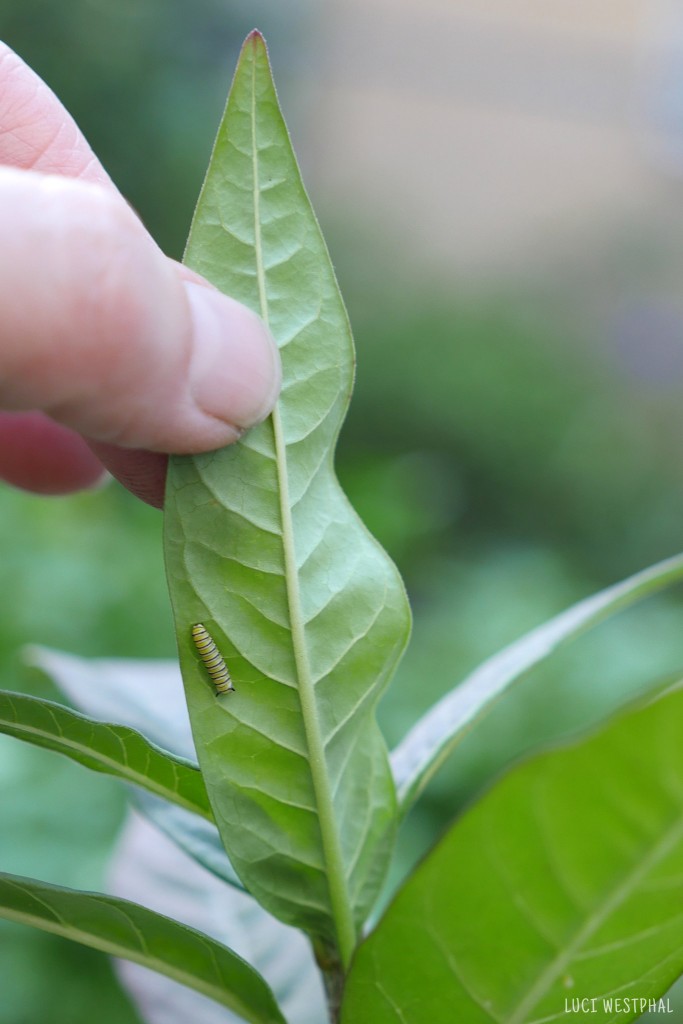
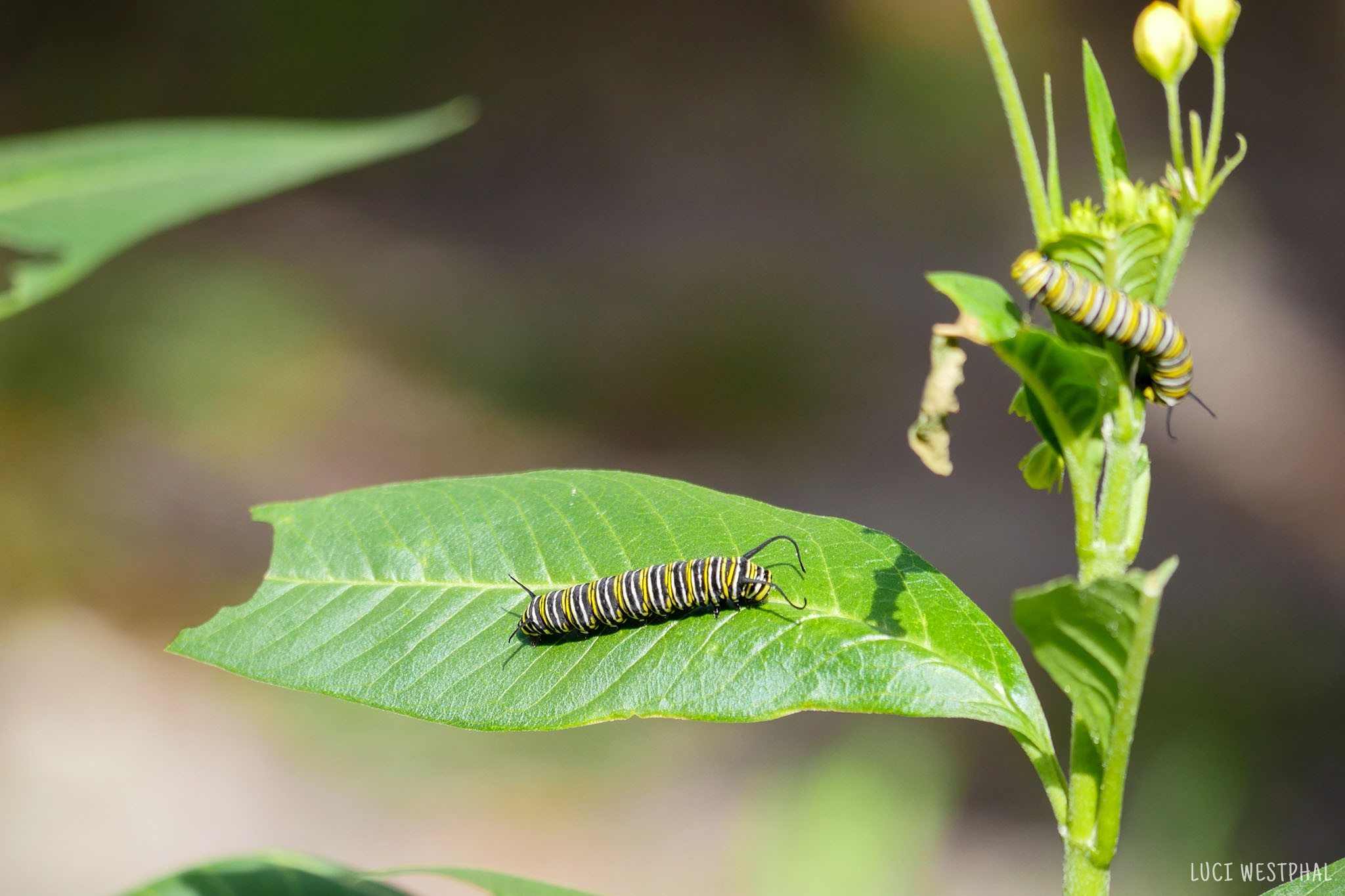
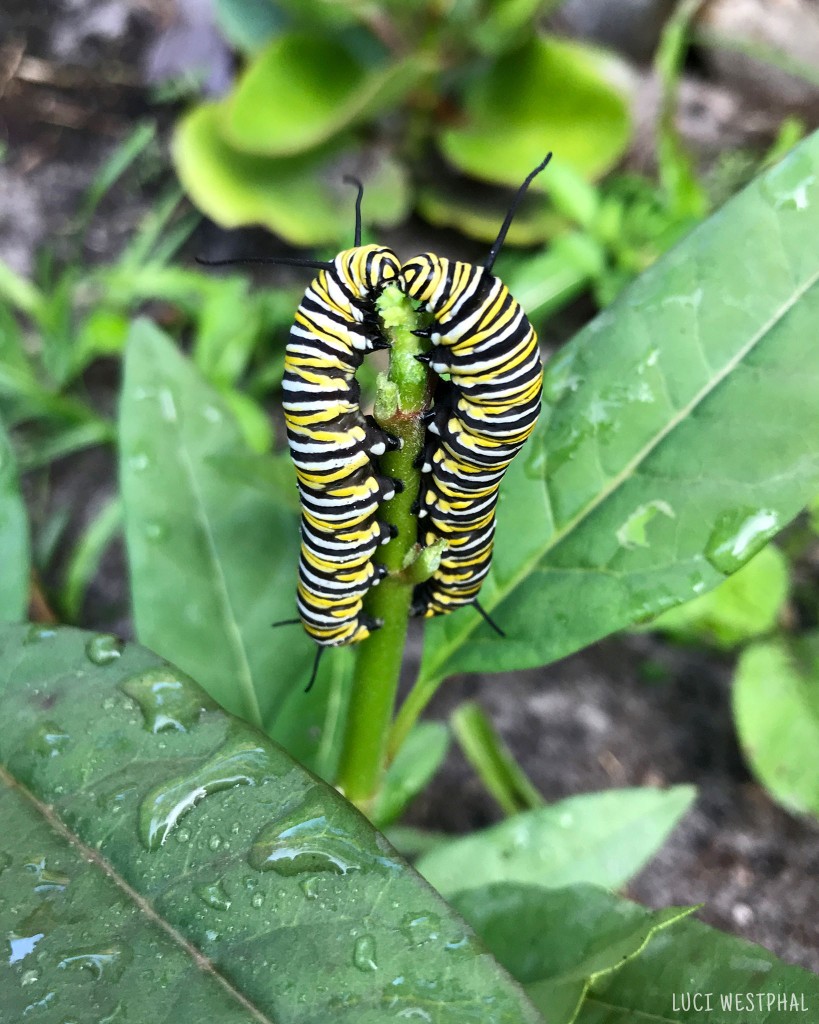
Turning Into A Chrysalis (Pupa)
Next, the caterpillar will find a place to just hang on and turn into a chrysalis. This does not have to be a milkweed plant – but preferably somewhere safe, where one doesn’t get knocked about.
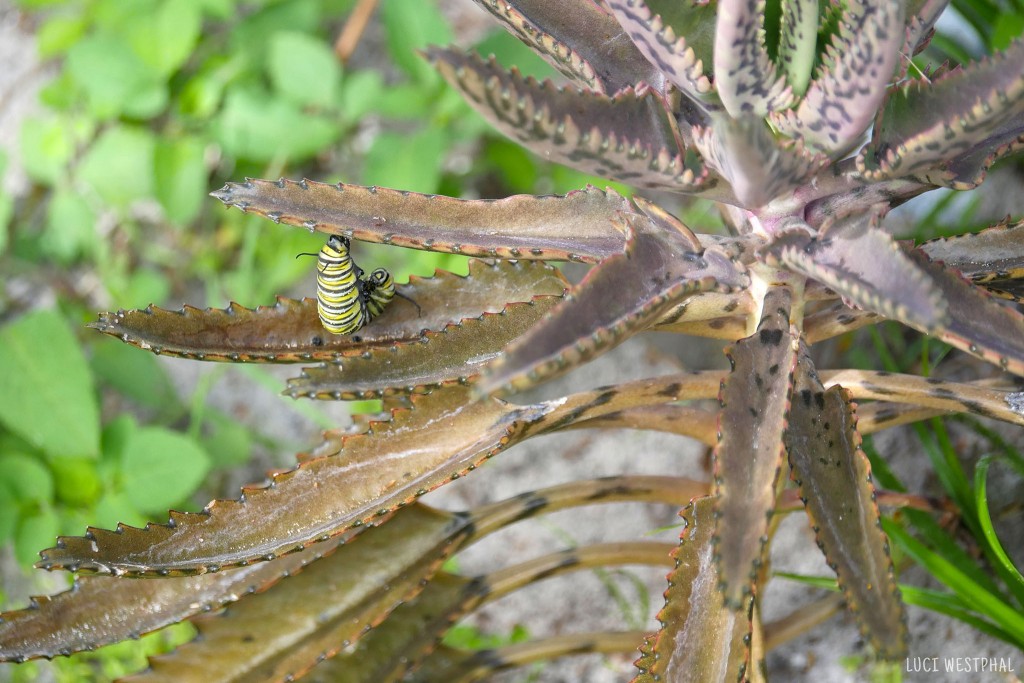
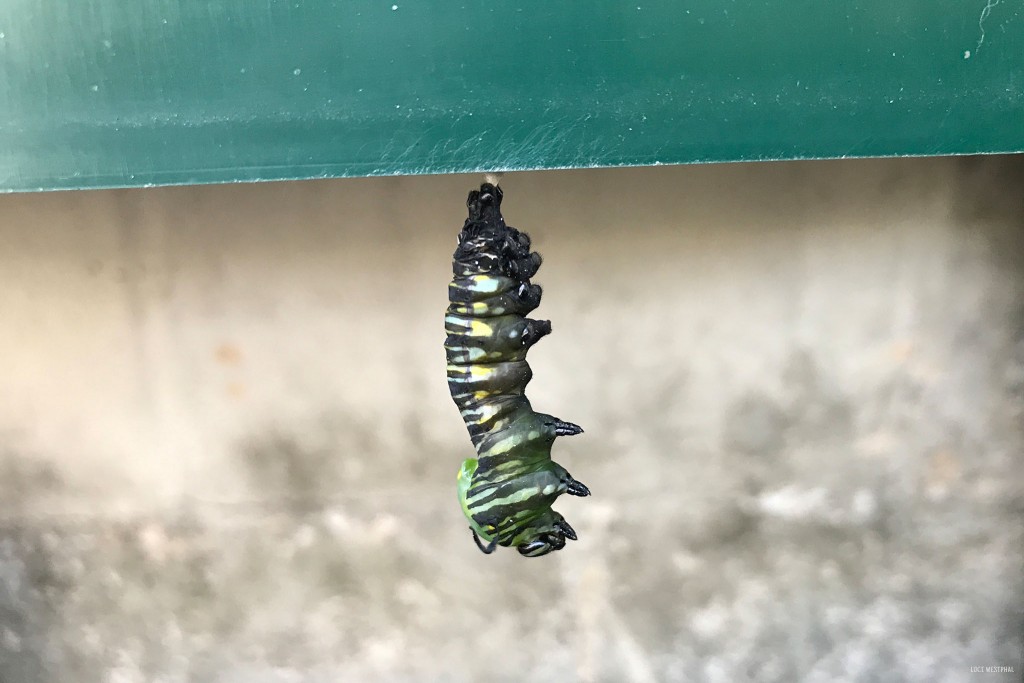

Monarch Life Cycle Stage: Chrysalis
For about 8 – 12 days, the chrysalis will appear to be doing nothing – but inside, the monarch butterfly metamorphosis is happening from larva via goo to butterfly!
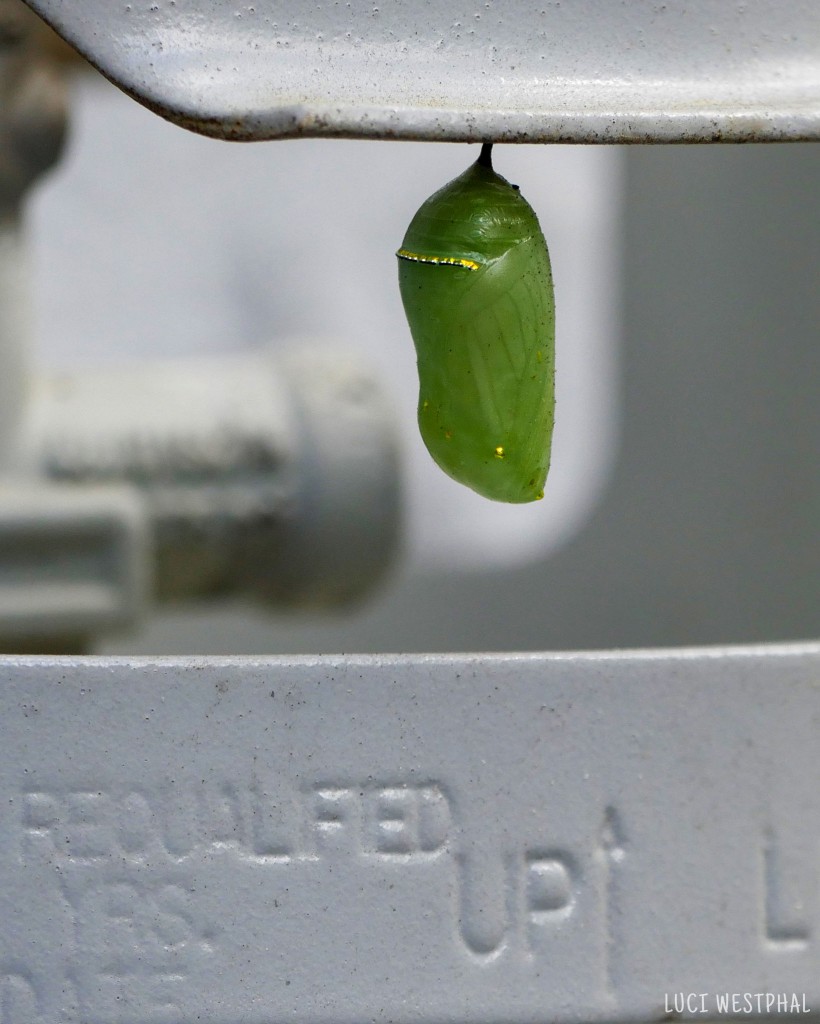
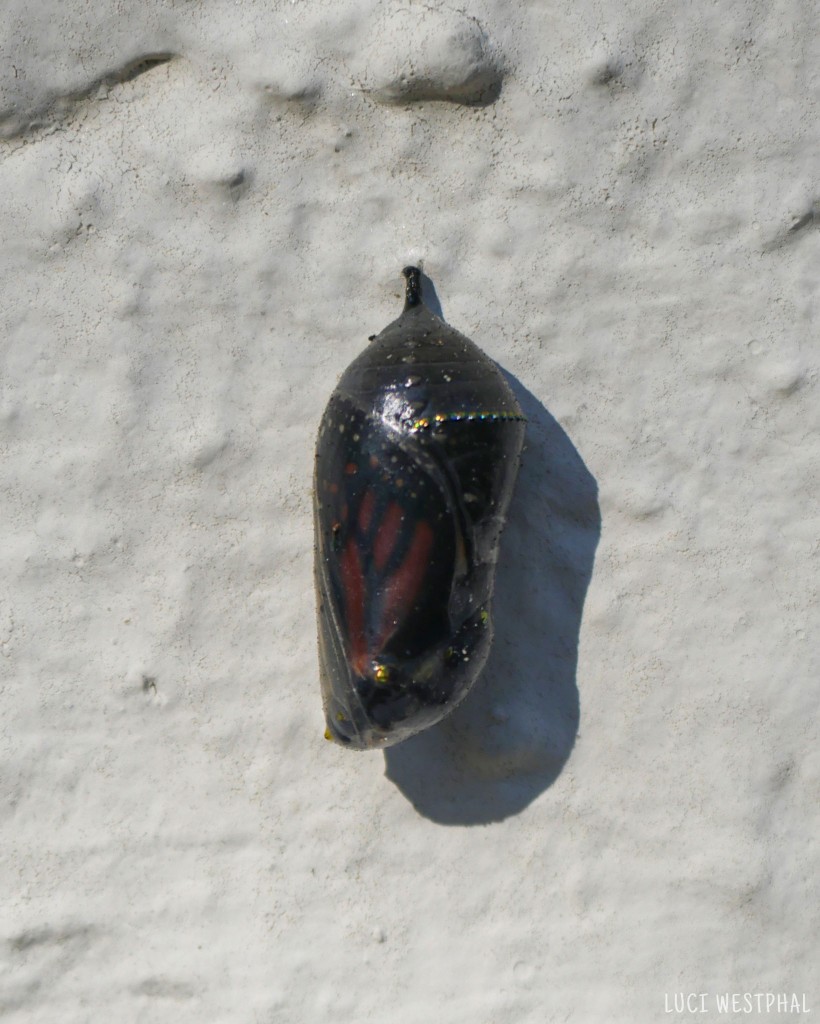
The Butterfly Finally Emerges!
The moment has finally arrived. And I felt so lucky that I got to witness what truly felt like a miracle: the monarch butterfly emerging from the chrysalis, unfurling its wings and pulling out its surprisingly long body. Thank you, Joanne, for watching and letting me know when this was happening. Hope I get to see one in my own yard soon – and from the very beginning of the first “opening pop”.
Here is a video I made of the monarch butterfly emerging from its thin chrysalis walls. This process usually only takes about 15 minutes. In this case it took about 45 minutes. To make this video only 2:15 minutes long, I chose just a few moments.
EDIT 5/14/21: Since I shot that first “butterfly emerges from chrysalis” video that inspired me to write this blog post, I watched and filmed a few more monarch butterflies pop out of their chrysalis. It turns out that the first one was having a very hard time. And I don’t think it’s representative anymore – and actually hard to watch. I’ve taken that video out of this blog post.
EDIT 8/14: Since that first time witnessing a monarch butterfly emerge from its chrysalis, I’ve got to watch and record a few more – and those all went smoothly. Now I got to notice and capture several other important aspects of the monarch turning from pupa into fully-developed butterfly.
- You know that a monarch butterfly is ready to emerge when the chrysalis has turned from green to what appears to be black – but really is translucent and revealing the black butterfly body and some of its furled wings. It will emerge within 24 hours.
- Then the monarch cocoon expands a bit near the top, just above the line of gold dots (between two “rings”). This is your heads-up that the butterfly will emerge in a few minutes. Get ready…
- Especially when you speed up the video (see the monarch butterfly emerges time-lapse video below), you can see how the pumping of the (at first short, round and eventually elongated) body is in sync with the “pumping up” of the veins in the butterfly wings which leads them to unfurl and straighten into the butterfly wings as we know them.
- If you keep watching, you’ll see the butterfly curl and uncurl its TWO “tongues” until they fuse and turn into one long proboscis / tongue / trunk that it needs to absorb nectar from flowers.
AND HERE FINALLY is the new video of a monarch butterfly emerging from its chrysalis (without complications). This video is sped up 600%. I plan on uploading another one in real time soon…
Or if you have the time to just watch the whole process in real time, here is the real-time 12-minute version of the same butterfly coming out of its pupa:
A few photos from that time-lapse video:
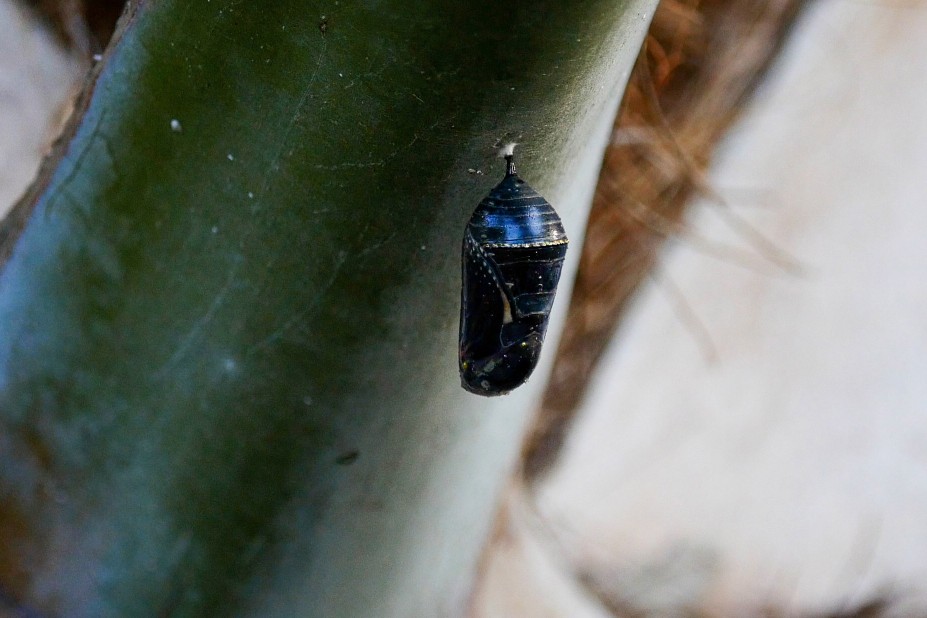
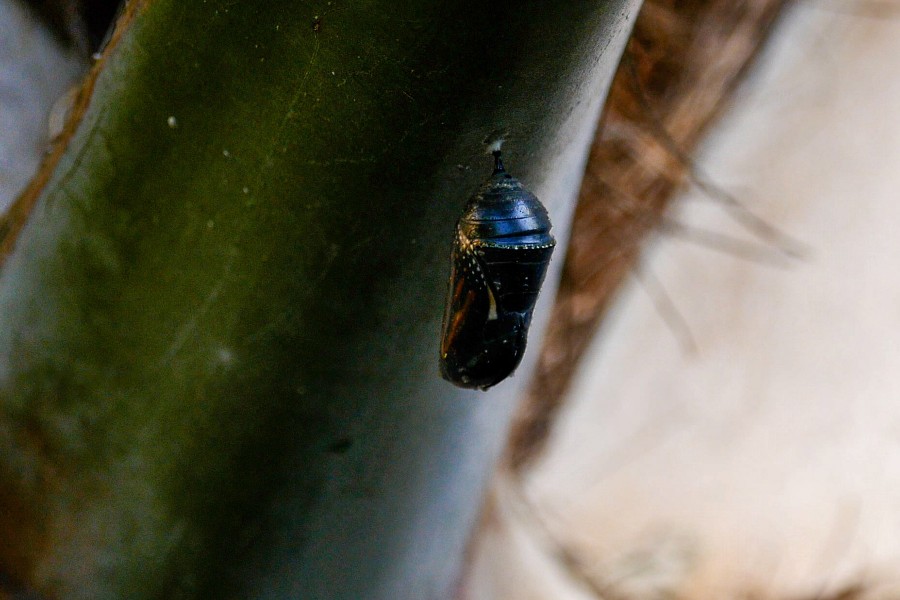
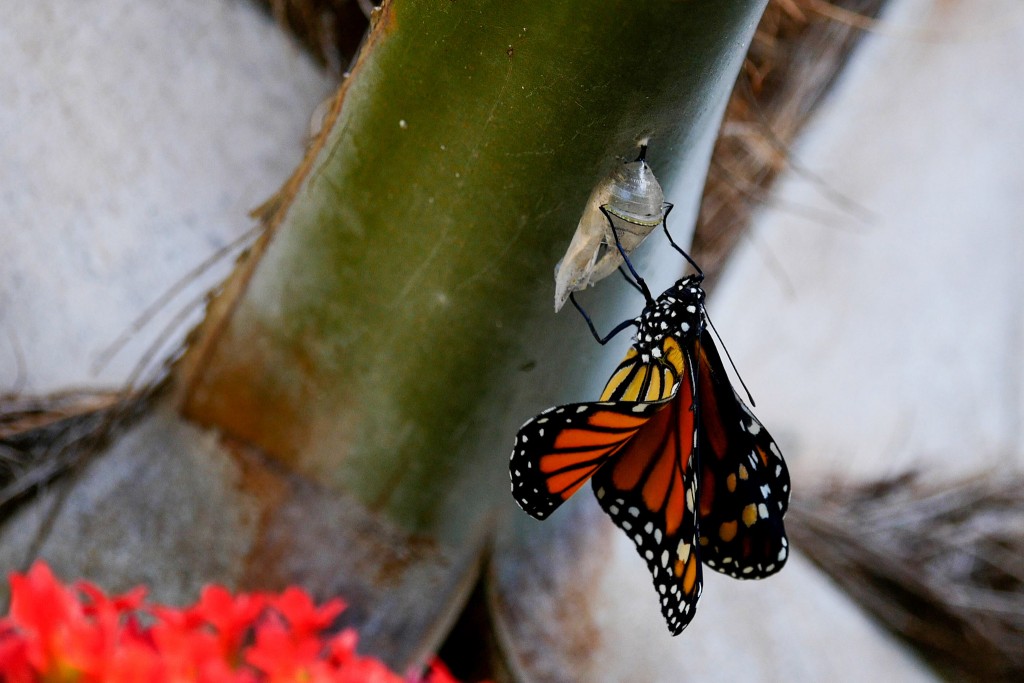
Here are a few photos I took in-between shooting the first video:
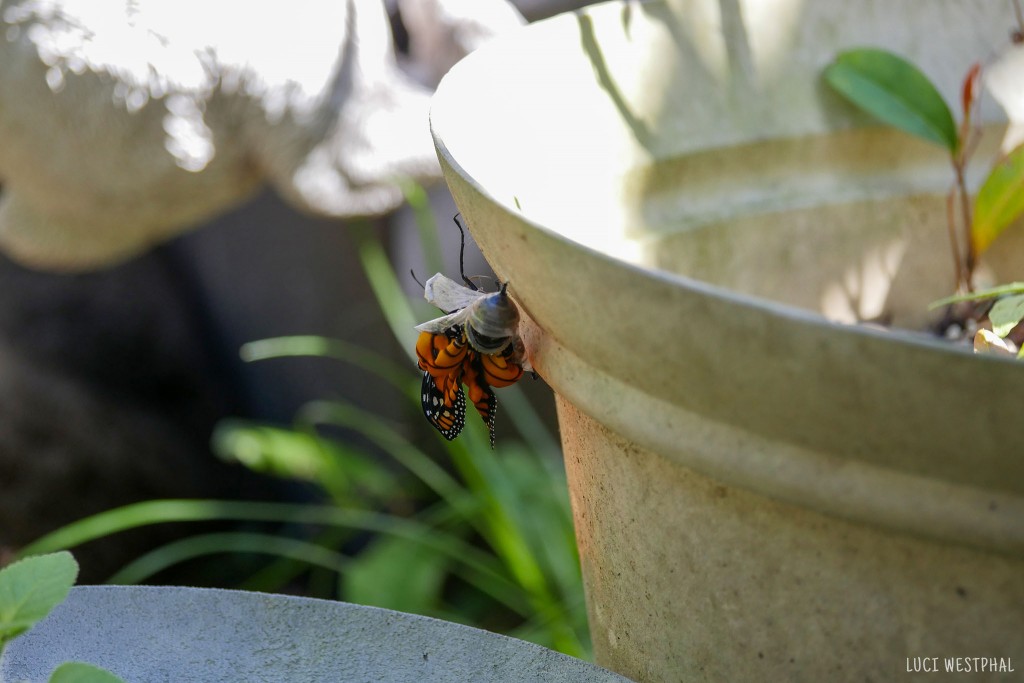
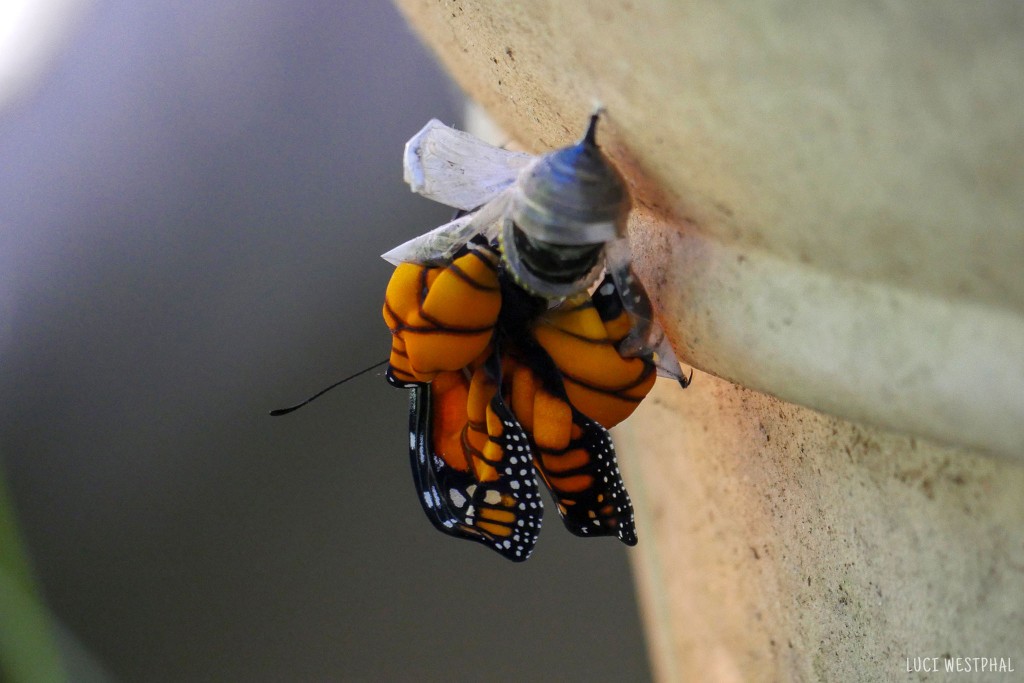
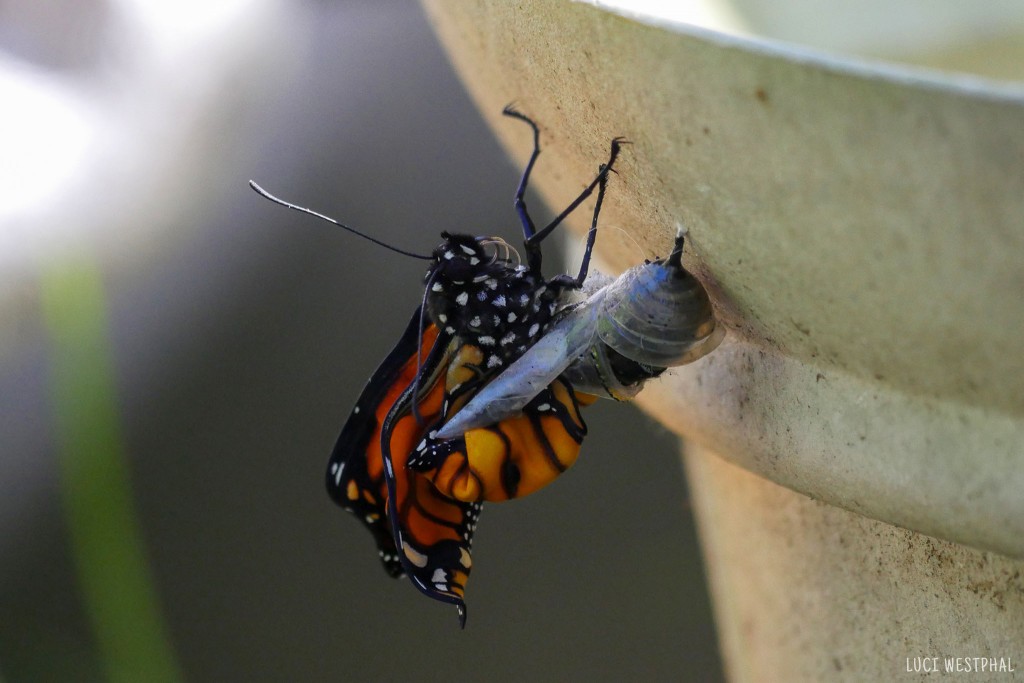
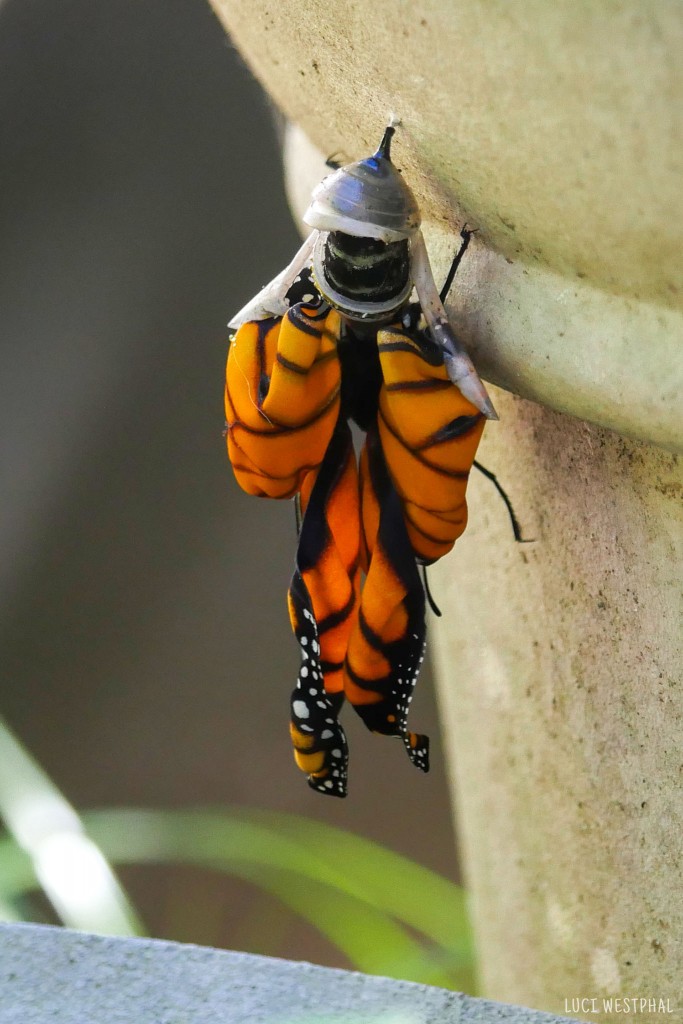
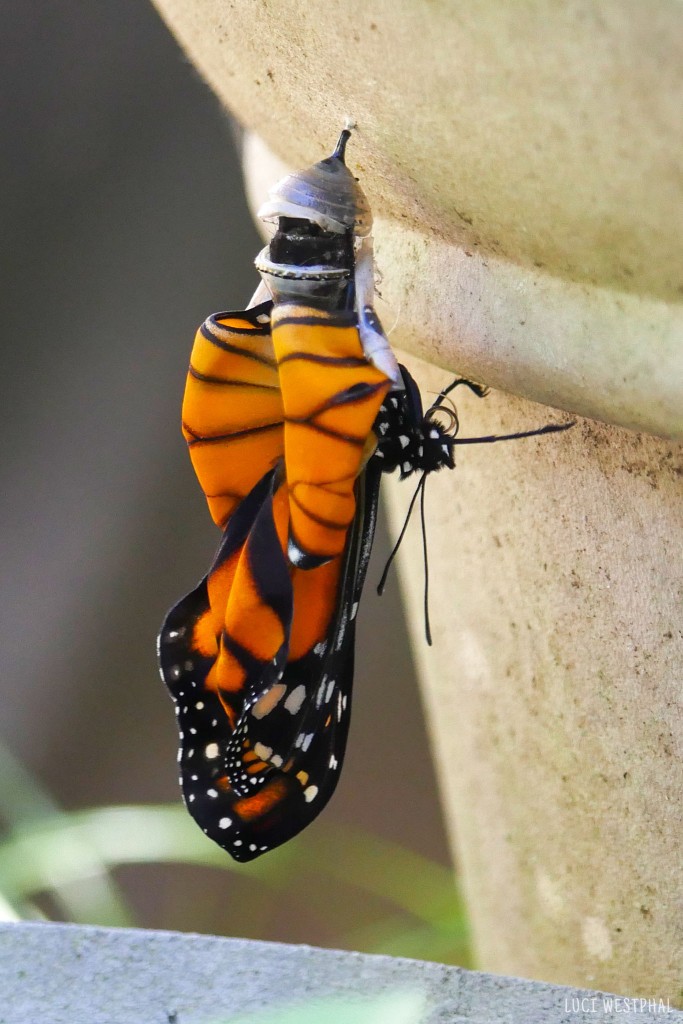
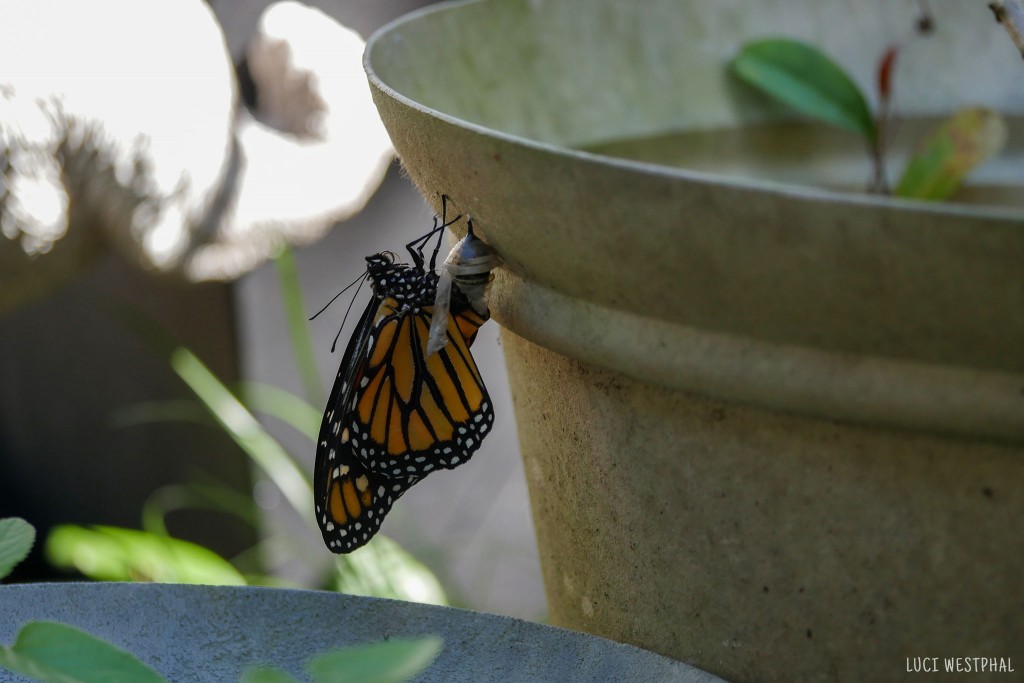

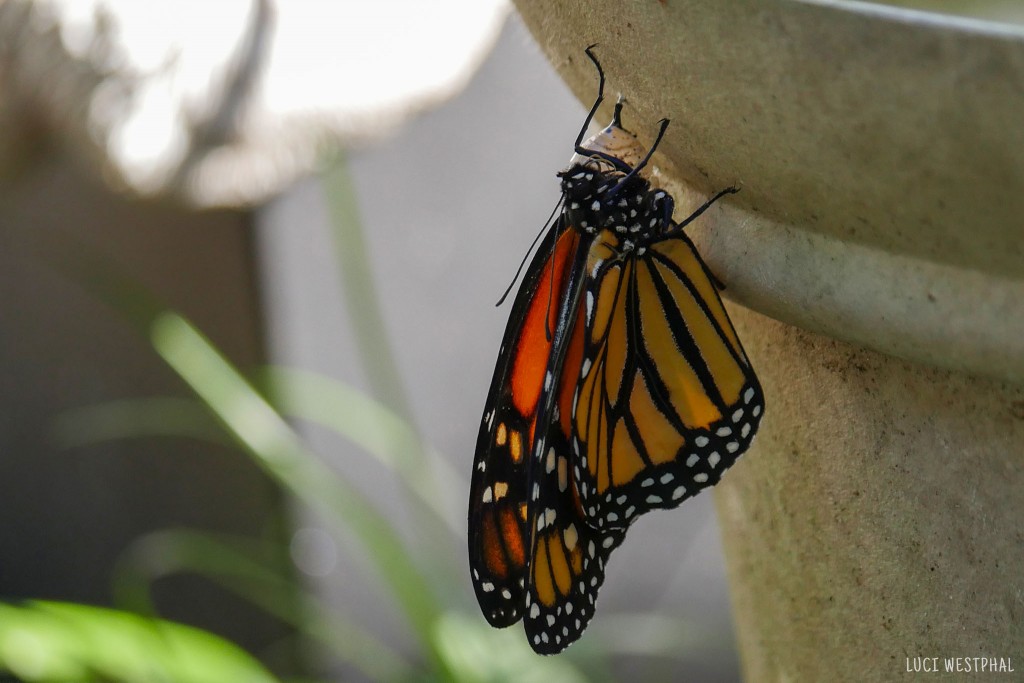
Monarch Life Cycle Stage: Butterfly Life
The regular female and male butterflies get to flutter around, consume nectar, and induce smiles for 2 – 6 weeks. The so-called super generation, the last generation of the season, usually born in late summer in the Northern US is the one that lives around 8 months and will migrate down to Mexico.
In Florida, we supposedly have some monarch butterflies that simply stay here and don’t migrate. Kind of like those Sandhill Cranes that live in Paynes Prairie year-round and can’t be bothered to fly back north again.
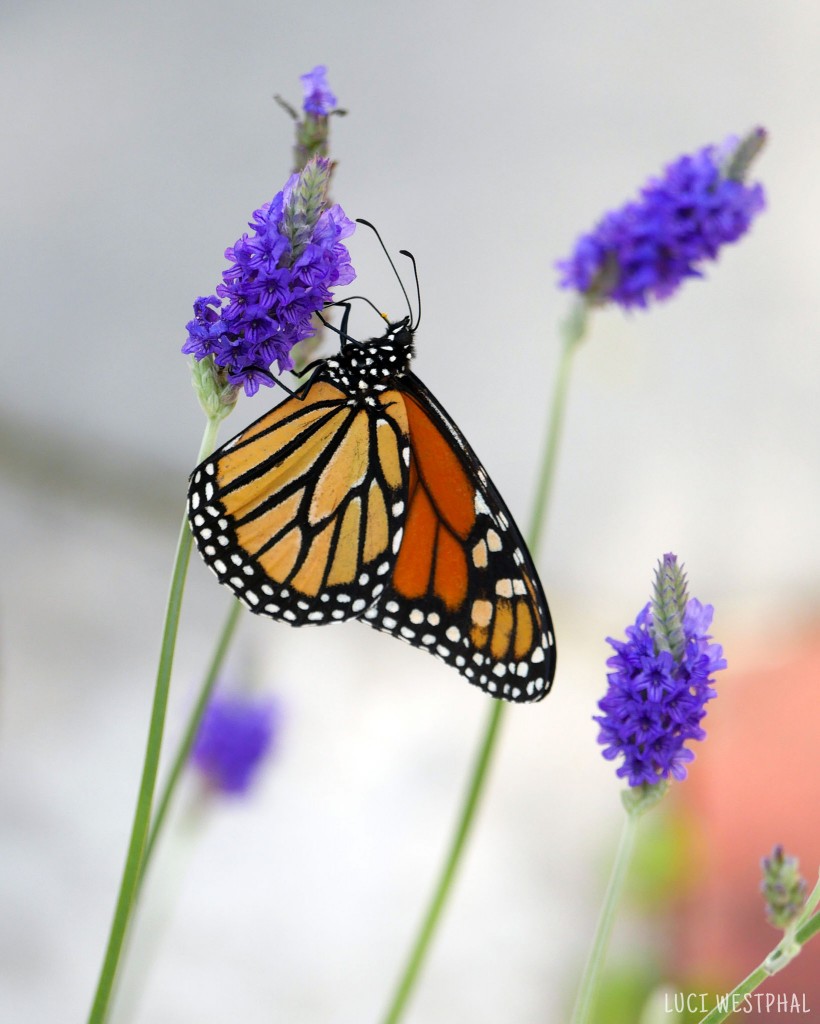
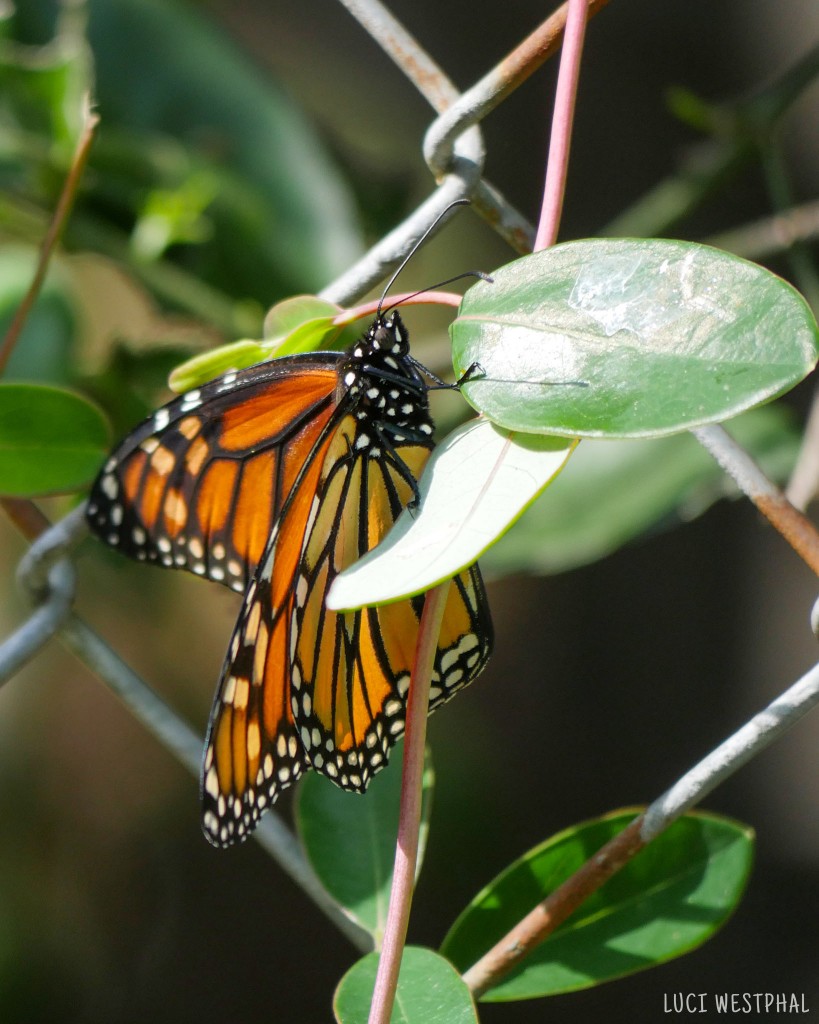
Monarch Life Cycle Stage: Eggs…
Throughout the few weeks of its life, the female monarch will lay eggs on the underside of milkweed leaves. That’s why we now have plants in different stages, too – just about matching the monarch butterfly life cycle stages. Some have grown new leaves since that plant’s larvae have moved on to their chrysalis phase – while other plants are being eaten by the next batch of larvae.
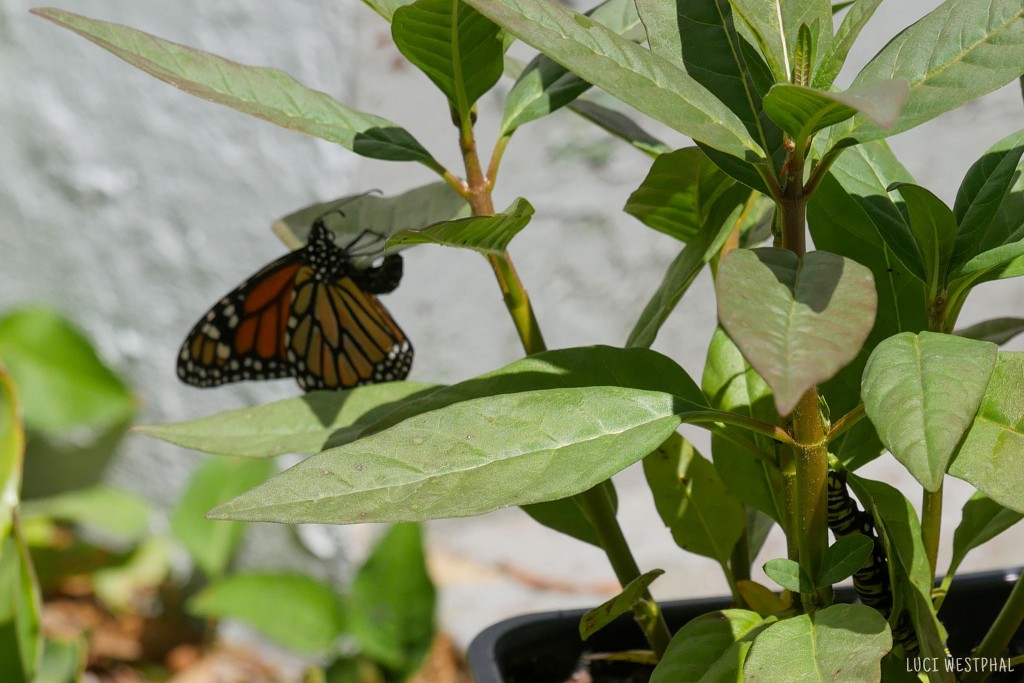
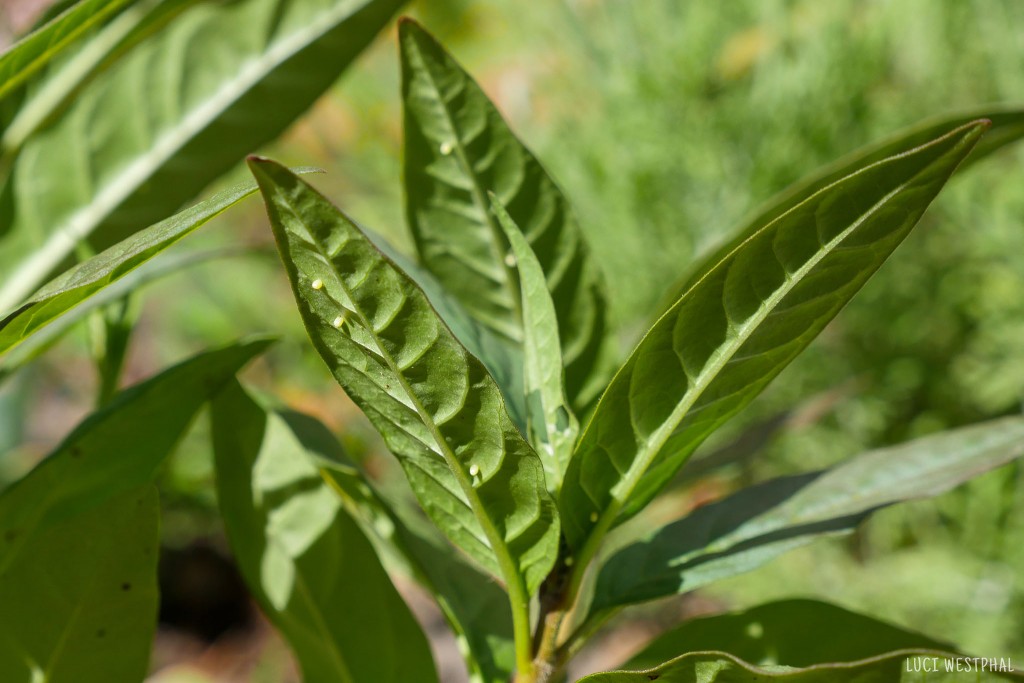
Behind The Butterfly Scenes
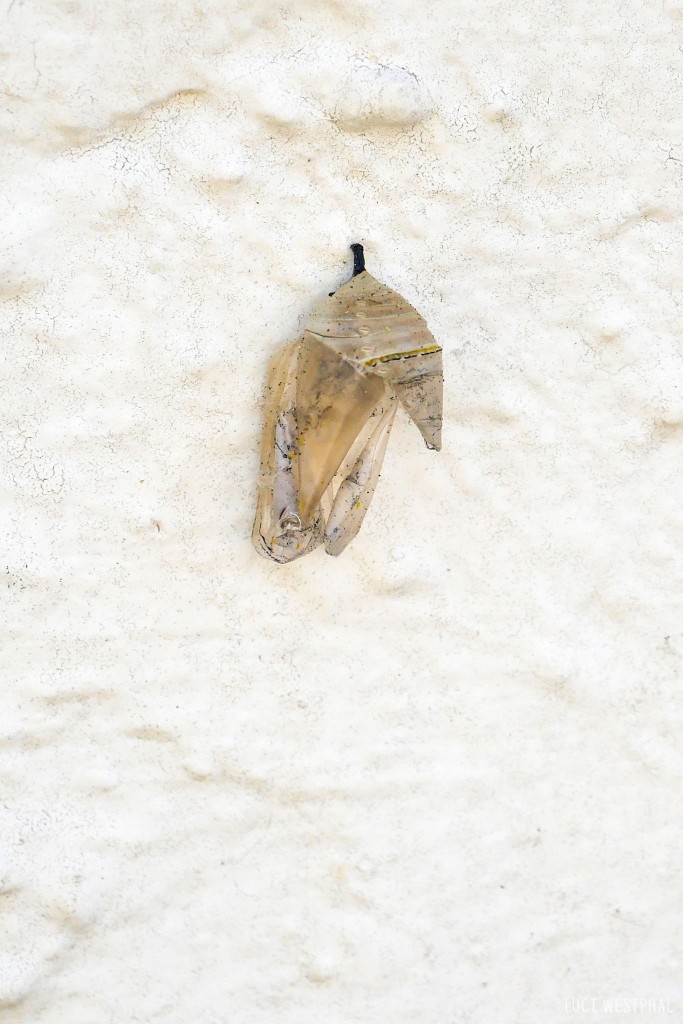
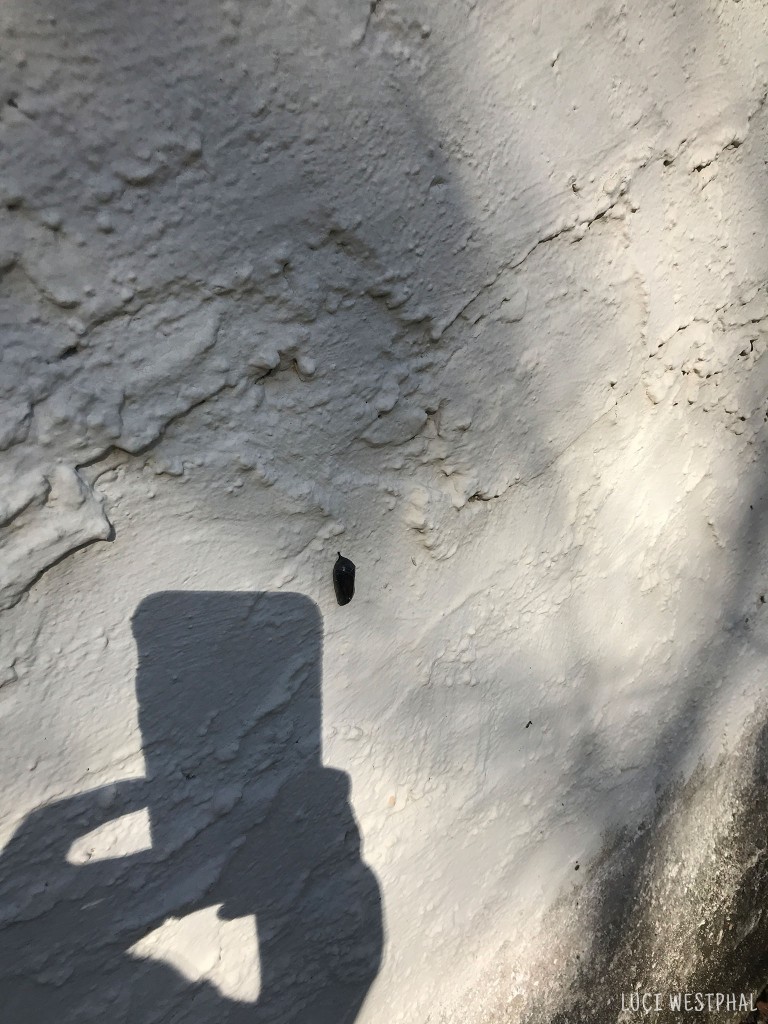
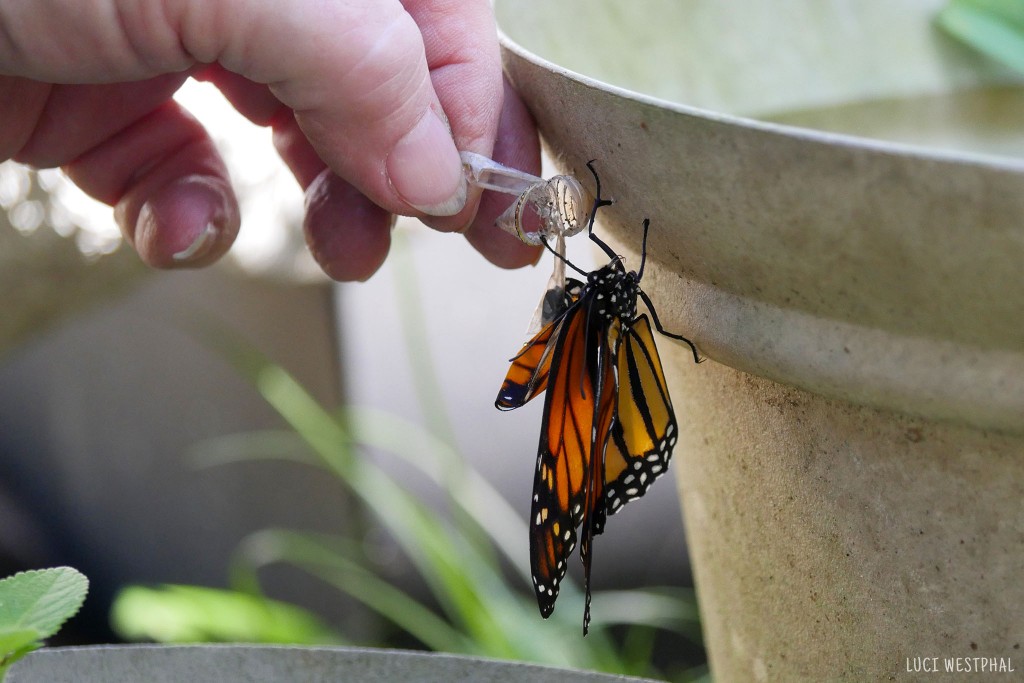
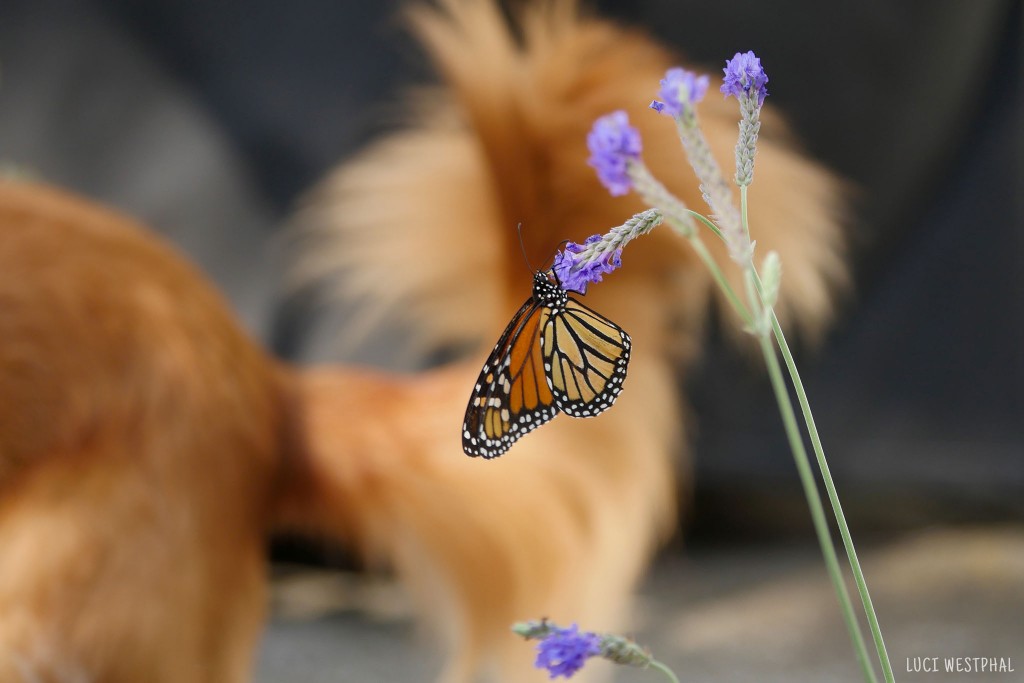
Share images on Pinterest:
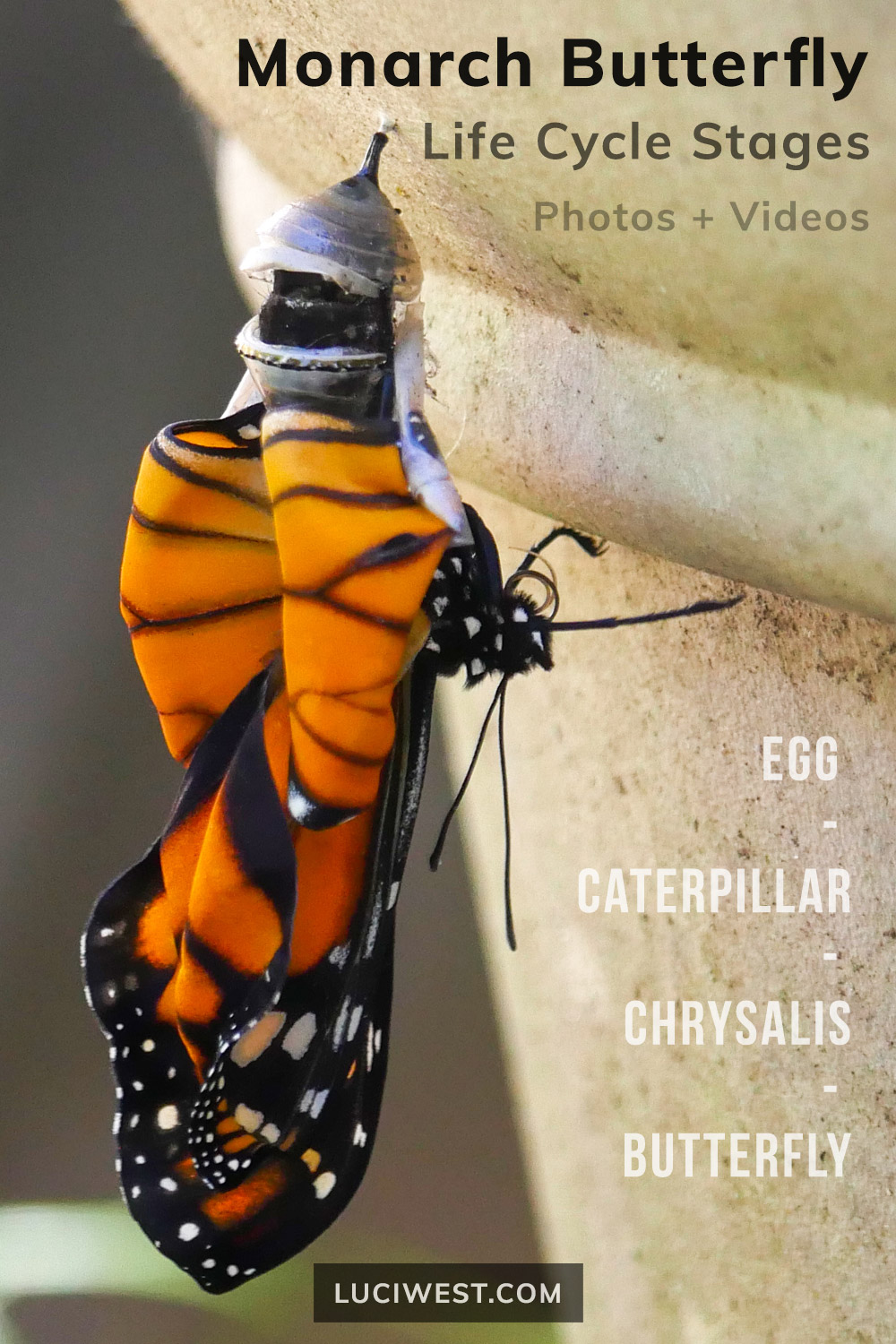
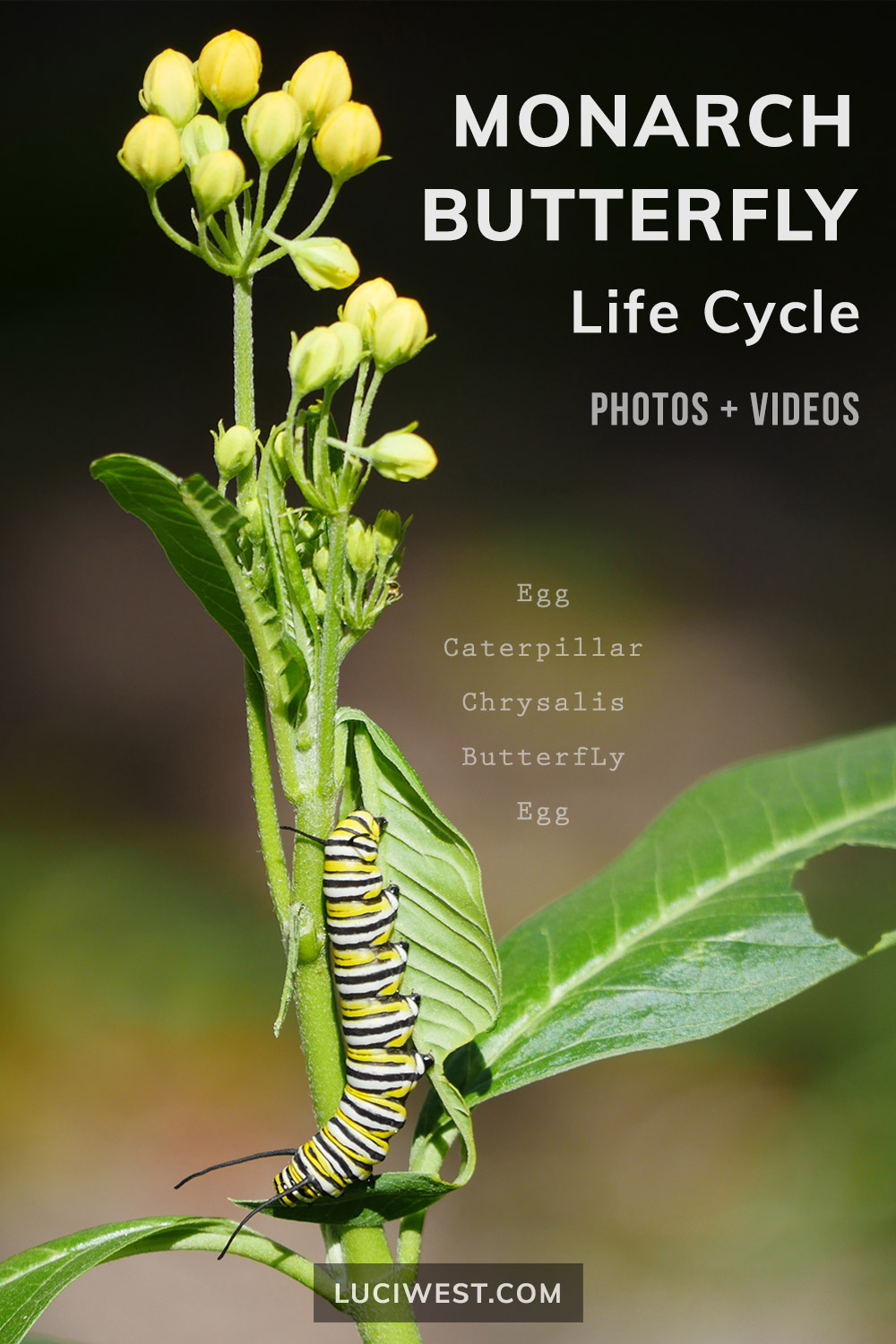
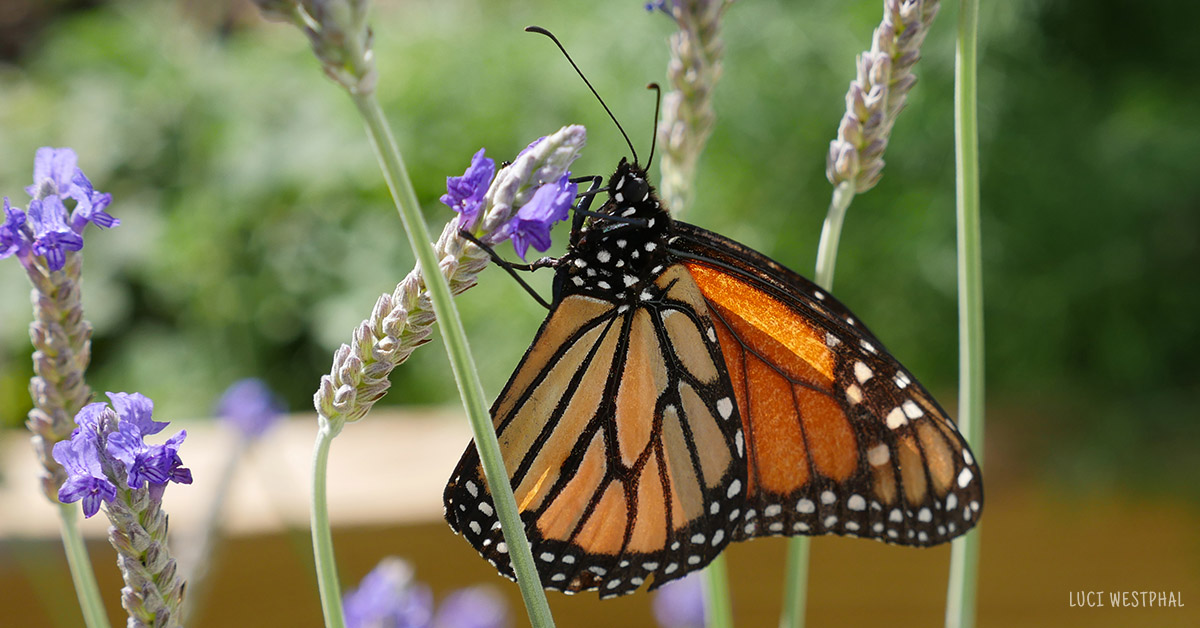
The way caterpillars turn into butterflies is just so lovely. Thank you.
Glad you think so, too. Thank you for your comment, Krysten.
MAGICAL. We’ve grown butterflies in our home with the kids watching every stage carefully and then releasing the butterflies into the wild. I am planting the flowers in my yard that cater to the butterflies. This year, I have more plans on a new set of milkweed plants that will allow these magical creatures to spread.
That’s so cool you’re doing that with your kids! What a great way to learn and appreciate the wonder of nature! I had no idea this was “a thing” people even did until this month. I just thought my neighbor happened to kindly provide extra milkweed plants to the butterflies that were already there. Now I’m hooked, too, and have several different kinds of milkweed plants in different stages – and with eggs and caterpillars and butterflies all around.
I loved following this as you posted and now, once again, when you have put it all together. Thanks!
Thank you so much, Dianne. Means a lot that after seeing some of them on social already, you came here to see the rest. It’s been so fun sharing this series in particular.
xx Luci
The photos are just stunning. You captured the beauty of the monarch butterfly’s growth. The beauty of nature is truly incomparable.
Thank you so much! And yes, it truly is incomparable – especially when witnessing something is intricate, astonishing, and beautiful as butterfly metamorphosis.
Wow this is so amazing,the life of a baby butterfly!
Interesting read! Love how you captured the whole process. I had no idea milkweed is poisonous. Thank you for sharing. I definitely learned something new today.
Thank you, Clarice!
Butterflies always have a beautiful life process. Reading this makes me appreciate them more.
They do! Glad reading this made you appreciate them even more.
Thank you so much for the great photos and funny competition video. Just started raising caterpillars three wks ago and loving every minute.
I have been trying to find the answer online with no luck. How long in mins/hours does the instar 1 to emerge from the egg once it begins to pop it’s head out. Seems like mine stay that way for a day. And then wahlah! I see them cruising around the hole they chewed.
Sorry for the super late reply. But now I wonder: did you ever figure out the timing of the instar 1?
Love your pictures and videos. This is the first time I’ve tried “raising” monarchs . The first chrysalis has turned dark overnight! Your information has been so helpful. Thank you!
I’m so glad my post could be helpful. It can be unsettling to see the dark chrysalis. By now, maybe your butterfly has already emerged? Or maybe later this afternoon… So exciting! Keep me posted.
xx Luci
This is my first attempt at raising Monarchs from eggs. Your video is extremely helpful. I am sitting in front of my habitat waiting for my first emerging butterfly. I have 4 stages sitting at the top of the habitat…one larva, one J shaped Larva, one green Chrysalis and one black Chrysalis.
How exciting, Jennifer! The black Chrysalis should open within the day. Enjoy seeing your butterfly emerge and take to the air… I’m glad my video was helpful. Thank you for leaving a comment.